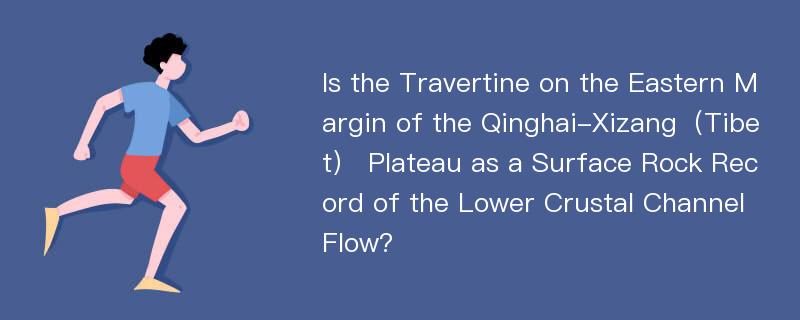
论文摘要
Although the Lower Crustal Flow(LCF)(Royden et al., 1997) pattern is still controversial in the study of the uplift dynamics in the eastern margin of the Qinghai-Xizang(Tibet) Plateau, however, geophysical data support this model, especially it can reasonably explain why such a large amount of energy accumulates deep in the eastern margin of the plateau while the surface deformation and movement rate are relatively low. The LCF is also considered to be a trigger for the intense seismic activity in the eastern margin of the plateau in recent years. It would be direct if some LCF information could be extracted from the rock record. However, the previous studies on Pengguan Complex and the intrusive rocks of Garzê Fold Belt are too weak to find any records of surface rocks(Zhang et al., 2004). Herein, we propose that the travertine on the eastern margin of the plateau is the best recorded rock of the LCF. Travertine is supersaturated with calcium carbonate in water due to CO2 emissions under appropriate physical, chemical or biological conditions, resulting in precipitation of calcium carbonate on different topography. The chemical equation is as follows: Ca2++2 HCO3-?CaCO3+CO2+H2O. The source of CO2 is particularly important for the understanding of the genetic mechanism of travertine. Therefore, previous studies(Pentecost, 1995) divided the travertine into two categories: atmospheric and thermogenic travertine. The former CO2 is drove by the degassing of the atmosphere and soil, and usually has a lower δ13 C(–12‰~ 2‰); the latter is mainly triggered by the degassing of CO2 from deep mantle or metamorphic genesis, with δ13 C –1‰~10‰. For the thermogenic travertine, the deepsourced CO2 dissolves in the groundwater to form the karst water in the carbonate rock area, and then begins his karstification, then, the travertine is deposited by the discharge of CO2 at the spring water. Thus, deep-sourced CO2 provides a source of vitality for travertine, where requires a robust engine in the deep, and the LCF is a potential producer. On the other hand, it carries, from the material properties of LCF, a heat source(depth of 45 ~ 72 km, corresponding to a temperature of 800 ~ 1100℃)(Lawet al., 2006), which is conducive to deep rock metamorphism and CO2 removal; From the perspective of channel flow operation mechanism, the peristalsis towards the southeast of the plateau will be decoupled when it encounters rigid ground block. The stress caused by the upward decoupling causes the uplift of the eastern margin of the plateau to be deformed, accompanied by the formation of active structures; the downward decoupling thickens the crust or inserts into the upper mantle, which in turn can open the CO2 channel of the mantle source. That is to say, whether decoupling up or down is beneficial to provide a path for CO2. It is precisely because of the existence of the LCF in the eastern margin of the plateau that the travertine in the region is linearly d
论文目录
文章来源
类型: 国际会议
作者: WANG Fudong,DONG Faqin,ENRICO Capezzuoli,ZHAO Xueqin
来源: 第九届世界华人地质科学研讨会 2019-06-01
年度: 2019
分类: 基础科学
专业: 地质学
单位: School of Environment and Resource, Southwest University of Science and TechnologyDepartment of Earth Science, University of Firenze
分类号: P588.245
DOI: 10.26914/c.cnkihy.2019.028364
页码: 153-154
总页数: 2
文件大小: 177k
下载量: 2
